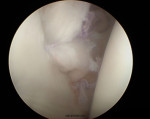Chronic Shoulder Instability
Chronic shoulder instability is the persistent inability of these tissues to keep the arm centered in the shoulder socket. There are three common ways that a shoulder can become chronically unstable:
1. Shoulder Dislocation

Severe injury, or trauma, is often the cause of an initial shoulder dislocation. When the head of the humerus dislocates, the socket bone (glenoid) and the ligaments in the front of the shoulder are often injured. The torn ligament in the front of the shoulder is commonly called a Bankart lesion. A severe first dislocation can lead to continued dislocations, giving out, or a feeling of instability.
2. Repetitive Strain
Some people with shoulder instability have never had a dislocation. Most of these patients have looser ligaments in their shoulders. This increased looseness is sometimes just their normal anatomy. Sometimes, it is the result of repetitive overhead motion. Swimming, tennis, and volleyball are some sports examples of repetitive overhead motion that can stretch out the shoulder ligaments. Many jobs also require repetitive overhead work. Looser ligaments can make it hard to maintain shoulder stability. Repetitive or stressful activities can challenge a weakened shoulder. This can result in a painful, unstable shoulder.
3. Multidirectional Instability
In a small minority of patients, the shoulder can become unstable without a history of injury or repetitive strain. In such patients, the shoulder may feel loose or dislocate in multiple directions, meaning the ball may dislocate out the front, out the back, or out the bottom of the shoulder. This is called multidirectional instability. These patients have naturally loose ligaments throughout the body and may be “double-jointed.”
Treatment For Chronic Shoulder Instability
The mainstay of treatment for all 3 types is still conservative treatment. This would involve aggressive physical therapy to strengthen the shoulder muscles and avoiding the activities that cause the instability. This works in most patients although studies have shown that the younger the patient is when he has his first dislocation, the more likely he is to get another dislocation.
Surgery for Shoulder Instability

Surgery is indicated when conservative treatment has failed and the instability is affecting the patient’s lifestyle, work or sports. For example, in a competitive baseball player who has difficulty throwing a fastball or someone who dislocates his shoulder in his sleep. During the surgery which is performed arthroscopically (keyhole surgery), we will repair the torn tissues (Bankart lesion) with suture anchors.
In some cases where the soft tissue is very loose, we will do an additional procedure to tighten up these soft tissues called plication or inferior capsular shift.
Rehabilitation for Shoulder Instability
After surgery, your shoulder may be immobilized temporarily with a sling. When the sling is removed, exercises to rehabilitate the ligaments will be started. These will improve the range of motion in your shoulder and prevent scarring as the ligaments heal. Exercises to strengthen your shoulder will gradually be added to your rehabilitation plan. Be sure to follow our treatment plan. Although it is a slow process, your commitment to physical therapy is the most important factor in returning to all the activities you enjoy.
It is important to make a complete recovery for your shoulder dislocation before it becomes a chronic shoulder instability condition. For the complete range of services from diagnosis to treatment to rehabilitation, visit our internationally recognised sports and joints surgeon, Dr Kevin Lee at Singapore Pinnacle Orthopaedic Group.
Looking For A Reliable Shoulder & Elbow Orthopaedic Specialist?
Fast Medical Attention, Transparent Fees
Make an appointment for comprehensive care for your Shoulder & Elbow problems!
